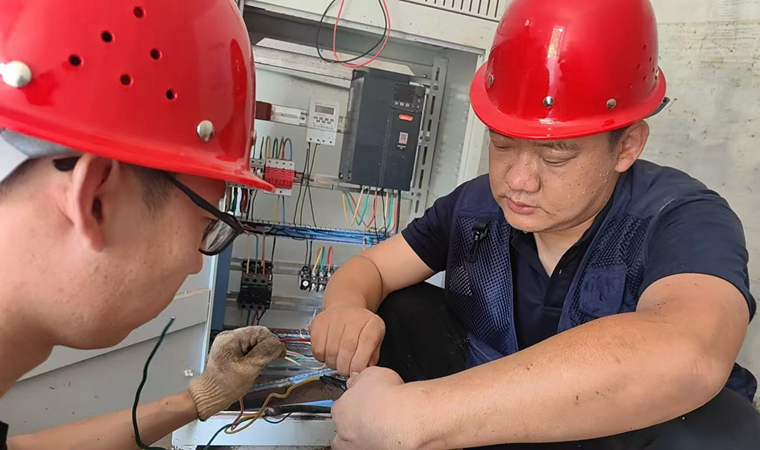Emergency workers are connecting pump power extension cables.
Currently, efforts to support the emergency restoration of rural water supply facilities in Miyun and Huairou districts are being accelerated. As of August 7, inspections of water source wells in 15 villages in Huairou District have been completed, with repairs finished for 5 villages. In Miyun District, inspections of 33 villages’ water source wells have been conducted, with repairs completed for one village.
From July 23 to 29, Beijing experienced continuous extreme heavy rainfall, causing severe damage in northern mountainous areas. Emergency plans were quickly developed to support the restoration of rural water supply facilities in disaster-stricken areas. Command centers were established in Miyun and Huairou to coordinate relief efforts.
Emergency workers clearing mud from equipment rooms and inspecting electrical distribution boxes.
On July 31, a repair team entered Detiangou Village in Liulimiao Town, Huairou District, to assess the water supply situation. Floods had destroyed roads around the village’s water pump station. The team cleared mud from the pump house, inspected water extraction, disinfection, and electrical equipment, and developed a repair plan overnight. Repairs were completed by 4 PM the following day after nearly 10 hours of work.
Technical teams discovered that some water source wells in villages like Zhen’an Village were clogged with mud, making water level measurements impossible. Some well chambers had walls and floors covered in mud, with electrical boxes and chemical dosing systems soaked and caked in sludge. Without power generation equipment on-site, workers insulated cables, documented conditions, and prepared repair plans.
In Qian’anling Village, Huairou, water pump station electrical cabinets were completely flooded, with sand and mud covering floors and pump openings. A repair team conducted on-site assessments and developed restoration plans. In Sunhugou Village, damaged roads forced workers to carry equipment over mountains and across rivers to complete inspections.
Two emergency teams with specialized equipment were dispatched to seven villages in Liulimiao Town. Workers first drained water from stations, then disassembled and inspected submerged electrical equipment, checking for short circuits and rusted components. After over 20 hours of repairs, three water source wells were restored.
On August 1, a repair team arrived at Piandaozi Village in Liulimiao Town. Workers cleared mud from pump stations and equipment, then carefully inspected power and water pump systems to prepare for restoration work.
Emergency water supply being provided to disaster areas.
“We are conducting comprehensive inspections of damaged water supply facilities, developing scientific repair plans, and coordinating resources to efficiently restore water source wells. For repaired systems, we are strengthening water quality testing to ensure public safety. Strict safety measures are being enforced to prevent secondary disasters and ensure smooth progress of relief efforts.”
Mobile integrated emergency water supply equipment in operation.
To date, support efforts have included deploying 174 personnel, 34 water trucks, 34 water tanks, 2 power generation vehicles, 100,800 disinfectant tablets, 100 kg of coagulant, 80,000 bottles of water, and 7,000 bags of water. Emergency water supply has been provided to 241 villages across 287 vehicle trips.
Miyun District
Miyun District, located in northeastern Beijing, China, is known for its scenic landscapes, including the Miyun Reservoir—a key water source for the capital. Historically, it was part of the Great Wall’s defense system, with ancient sections like Gubeikou and Simatai showcasing Ming Dynasty architecture. Today, it blends natural beauty with cultural heritage, attracting tourists for outdoor activities and historical exploration.
Huairou District
Huairou District is a suburban area located in northeastern Beijing, China, known for its scenic landscapes, including parts of the Great Wall and the Yanqi Lake. Historically, it has been a retreat for emperors and is now a popular destination for hiking, conferences (hosting the 2014 APEC summit), and eco-tourism. The district blends natural beauty with cultural heritage, offering attractions like the Mutianyu Great Wall and Hongluo Temple.
Detiangou Village
Detiangou Village is a traditional rural settlement in China, known for its well-preserved cave dwellings (yaodong) and unique loess plateau landscape. Historically, it reflects the agricultural lifestyle and architectural ingenuity of northern Shaanxi Province, where people have carved homes into the hillsides for centuries. Today, it serves as a cultural heritage site, offering insights into China’s rural history and sustainable living practices.
Liulimiao Town
Liulimiao Town, located in Hebei Province, China, is a historic town known for its association with the famous Chinese novel *Water Margin* (*Shuihu Zhuan*). It is traditionally believed to be the home of the legendary Song Jiang, a heroic outlaw leader from the 12th century. Today, the town features cultural relics and temples dedicated to the novel’s characters, attracting visitors interested in Chinese folklore and history.
Zhen’an Village
Zhen’an Village is a historic rural settlement in China, known for its well-preserved traditional architecture and cultural heritage. Dating back to the Ming and Qing dynasties, the village features ancient homes, ancestral halls, and stone-paved pathways, reflecting centuries-old rural life. Today, it serves as a cultural site, offering insights into China’s agrarian history and traditional village customs.
Qian’anling Village
Qian’anling Village is a traditional rural settlement in China, known for its well-preserved cultural heritage and historical architecture. The village reflects the agricultural lifestyle and customs of its region, with some structures dating back several centuries. While specific historical details may vary, it represents the enduring rural traditions and community life of northern China.
Sunhugou Village
Sunhugou Village is a traditional rural settlement in China, known for its well-preserved architecture and cultural heritage. Historically, it reflects the agricultural lifestyle and customs of the region, with some structures dating back several centuries. The village offers a glimpse into China’s rural past, attracting visitors interested in history and traditional culture.
Piandaozi Village
Piandaozi Village is a traditional Manchu ethnic village located in Liaoning Province, China, known for its well-preserved Qing Dynasty architecture and cultural heritage. Established over 300 years ago, it served as a military settlement during the Qing Dynasty and retains historical features like ancient courtyards and ancestral halls. Today, it offers visitors a glimpse into Manchu traditions, including folk customs, crafts, and festivals.





